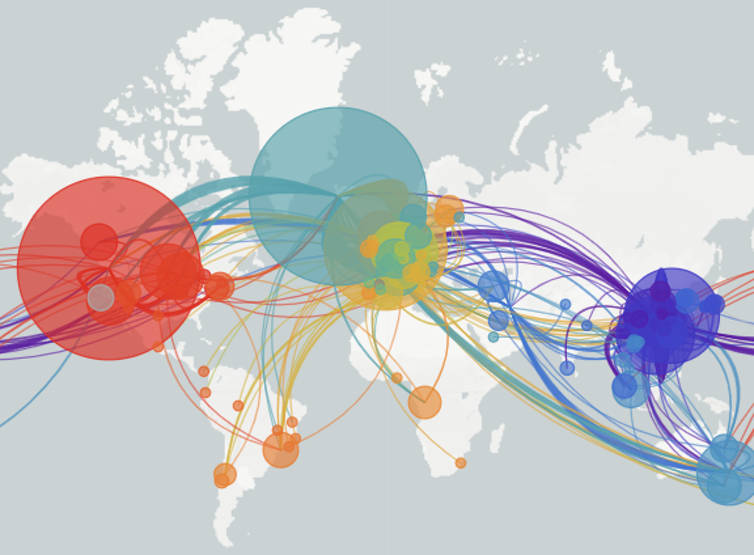The coronavirus was still a far-away problem in Wuhan when U.S. President Donald Trump announced a ban on travel from China in late January 2020. Six weeks later, as the coronavirus ravaged Italy, Trump closed travel from Europe.
These travel bans were highly controversial. Some people argued that they were unnecessary restrictions on travel. Others said they came too late. As New York’s COVID-19 case numbers shot upward, Gov. Andrew Cuomo said the U.S. had “closed the front door with the China ban … but we left the back door wide open,” because the virus had already spread to other countries.
One big question remains: Once the virus was in the U.S., how much impact did international travel actually have on COVID-19 cases and deaths?
As researchers with experience studying airlines, we pulled together data to start answering that question. We compared COVID-19 cases and deaths in nearly 1,000 U.S. counties against the numbers of passengers arriving in each from two countries targeted by the bans – China and Italy.
Our results, released as a preprint study, suggest that travelers coming from Italy drove the first wave in the U.S. more than those from China. They also point to two conclusions about travel bans:
First, if a government is going to impose a travel ban, it should act quickly. The virus spreads fast.
Second, don’t impose narrow travel bans that just target individual countries. Because the virus spreads so quickly, you have to assume the virus has already spread to other countries.
We are discussing our findings before the paper has undergone peer review because the results are important for decisions being made now. On Jan. 25, 2021, almost a year after Trump’s ban on travel from China, the Biden administration issued new travel bans on countries that have rising numbers of new fast-spreading variants of SARS-CoV-2.
Italy versus China
In our study, we used data on international airline travel and U.S. county-level statistics on COVID-19 cases and deaths. We wanted to find out: Did U.S. counties with more arrivals from two initial COVID-19 hot spots – Italy and China – experience more COVID-19 cases or deaths during the first U.S. wave of the pandemic?

Nextstrain, CC BY
There are several challenges in trying to assess the relationship between international travel and COVID-19 outbreaks. Fewer people might travel to cities that are in the midst of a pandemic outbreak. The areas that attract many foreign travelers may also have more severe COVID-19 outbreaks for other reasons. For example, places attracting a lot of foreign travelers may have more large events such as conferences and sporting events.
We used data on passengers arriving from non-COVID-19 hot spots to help control for these factors. We also took into account other factors that can affect the virus’s spread and impact, such as population size and density, use of public transportation, demographics, policies and economic activity.
We came away with two key results:
-
U.S. counties that received more passengers from China at the beginning of the pandemic did not experience higher COVID-19 infection and fatality rates than other counties on average through May 2020; in fact, both outcomes were lower.
-
Counties that received more passengers from Italy at the beginning of the pandemic experienced higher COVID-19 infection and fatality rates. Specifically, an additional 100 passengers from Italy arriving in a given county during the fourth quarter of 2019 corresponded with an increase in both case and death rates of about 5%.
Benefits of broader bans
Our preliminary results suggest that travelers coming from Italy drove the first wave in the U.S. more than those from China. Other researchers have linked the predominant strain of virus in New York City early in the pandemic to Europe.
Based on our evidence, the relatively early ban on travel from China appears to have been effective in reducing cases and deaths.
In late January 2020, when Trump shut down flights from China, the virus may have not yet spread widely enough among travelers from China to significantly contribute to the early wave of the pandemic in the U.S. Waiting until mid-March to impose a ban on travel from Europe, however, may have had deadly consequences.
The lesson: If a travel ban is warranted, time is of the essence.
Does that mean future bans will work?
Although our results provide strong evidence that international travel from Italy increased the spread of COVID-19 in the U.S. during the first wave of the pandemic, this occurred at a time when people were largely unaware of the virus and the threat that it posed.
Today, with both travelers and policymakers aware of the threat, it is uncertain what effect international travel would have on the spread of COVID-19 in the U.S. At the same time, new, more transmittable strains of the virus increase the threat from international travel. If the evidence does warrant additional travel restrictions, our research says to act quickly and think broadly.

